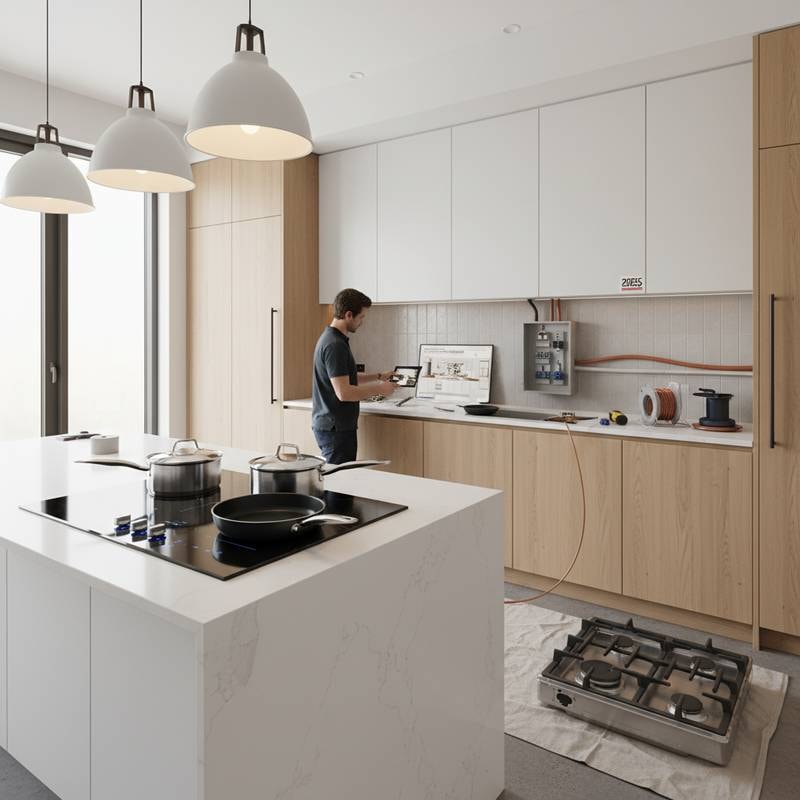Gas to Induction: Understanding Kitchen Conversion Costs
The modern kitchen evolves with technology that enhances performance, safety, and sustainability. Homeowners increasingly consider switching from gas to induction cooking for these benefits. This guide explores the costs involved, from appliances to installations, to help plan an effective upgrade.
Why Switch to Induction Cooking
Induction cooking uses magnetic fields to heat cookware directly, bypassing open flames or coils. This approach provides precise temperature control and energy efficiency. Leading brands such as Miele, Bosch, and GE Profile offer models with sleek designs and responsive interfaces.
Homeowners value the safety features, as surfaces remain cool outside the pan area. Cleanup proves simple, with spills wiping off easily and no residue from combustion. Visually, induction cooktops feature smooth glass tops in black ceramic or stainless steel, contributing to a minimalist kitchen aesthetic.
Breaking Down Appliance and Installation Costs
Conversion expenses vary based on existing infrastructure and chosen appliances. Expect to invest in both the cooktop and necessary modifications. High-quality induction cooktops start at around $1,000 and reach $5,000 for premium options like the Wolf Transitional or Gaggenau 400 Series, depending on size, power, and features.
Electrical upgrades form a significant portion of the budget. Induction requires a 240-volt dedicated circuit, often necessitating new wiring, breakers, and possibly a panel upgrade in older homes. Professional electricians typically charge $500 to $3,000 for this work, influenced by wiring distance and home age.
Cabinetry and countertop adjustments add further costs. Induction units may require resized cutouts in materials like marble or quartz. Fabricators charge $200 to $800 for these modifications, ensuring a secure fit.
Addressing Ventilation and Power Requirements
Ventilation systems deserve attention during conversion. Induction produces less heat, yet effective hoods remove steam and odors efficiently. Existing gas-designed vents might need replacement with compact downdraft options from Broan Elite or Faber Inca Smart, costing $300 to $1,500.
Power supply limitations in older homes can lead to unexpected expenses. A full panel upgrade ensures compliance with electrical codes and supports future appliances. These upgrades, priced at $1,000 to $4,000, provide long-term reliability.
Integrating Induction into Kitchen Design
Induction alters the kitchen's visual dynamics. Gas ranges often feature prominent grates, while induction offers a flat, reflective surface. Designers such as Sarah Sherman Samuel and Amber Lewis pair it with warm elements like oak cabinets, brass hardware, and textured walls for balance.
Color choices enhance harmony. Black glass cooktops complement charcoal counters or neutral shades like Classic Gray from Benjamin Moore. The reflective quality brightens spaces, making smaller kitchens appear larger.
Insights from Designers and Electricians
Architect Michael Chen of Michael K. Chen Architecture notes that induction suits open-plan layouts. “It allows the kitchen to feel calm and integrated,” he explains. “Without visible flames or heavy grates, the counter becomes part of the room’s architecture.”
Electrical contractor Lena Ruiz of Bright Current Electrical emphasizes preparation. “Clients often underestimate the electrical side. A clean installation requires proper amperage and grounding. Once that’s handled, induction cooktops perform beautifully for decades.”
These perspectives highlight how design and technical elements combine for functional spaces.
Performance Comparison: Gas and Induction
Induction excels in speed and precision, boiling water quicker and maintaining steady simmers. It supports delicate tasks like tempering chocolate without hot spots. Safety improves, as the surface avoids burns away from cookware.
Gas offers visual feedback and a traditional feel, appealing to some chefs. However, induction matches accuracy while saving energy. The decision hinges on cooking preferences and sustainability goals.
Environmental Benefits of Induction
Induction avoids combustion, reducing indoor emissions like nitrogen dioxide. It transfers nearly 90 percent of energy to the cookware, minimizing waste. This efficiency aligns with broader electrification trends in homes.
Pairing with solar panels amplifies benefits, lowering utility costs over time. The investment supports eco-friendly living with reduced maintenance needs.
Budgeting for a Smooth Conversion
Start with an electrical assessment to identify needs. Select a cooktop that matches your layout and style. Allocate 10 to 20 percent of the budget for contingencies.
Key cost categories include:
- Cooktop purchase ($1,000–$5,000)
- Electrical installation ($500–$3,000)
- Cabinetry adjustments ($200–$800)
- Ventilation updates ($300–$1,500)
- Finishing touches ($100–$500)
Consult a certified electrician and designer to align technical and aesthetic elements.
Selecting the Ideal Induction Cooktop
Evaluate space constraints and controls when choosing. Flush-mount models integrate seamlessly into counters, while framed ones add definition. Features like touch interfaces and smart sensors enhance usability.
For smaller areas, consider a 24-inch Bosch 500 Series unit. Larger kitchens benefit from 36- or 48-inch Thermador Freedom models with flexible zones. Coordinate finishes with other appliances for a unified look.
Embracing the Benefits of Your Upgraded Kitchen
Post-conversion, the kitchen gains efficiency and serenity. Induction's quiet operation fosters focused cooking, with faster cleanup and no gas maintenance. This upgrade elevates daily routines through better light flow and intuitive technology.
Thoughtful planning ensures the space delivers comfort and style for years. The result combines practical performance with enduring design appeal.









